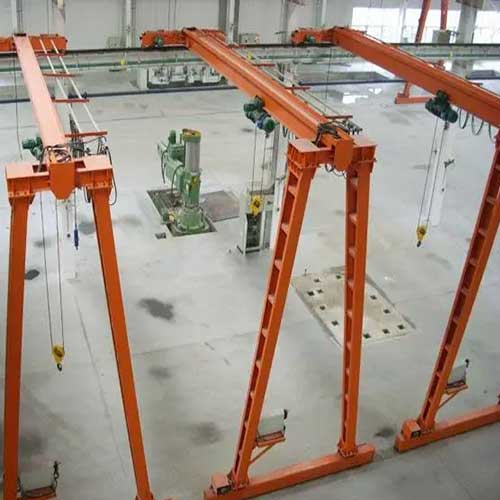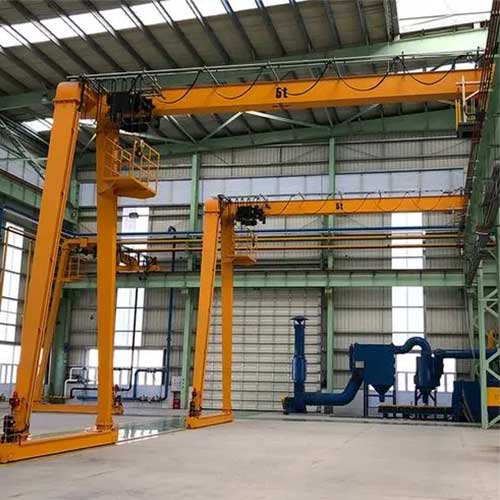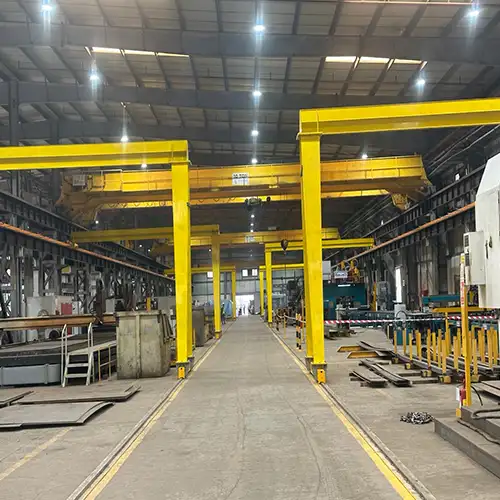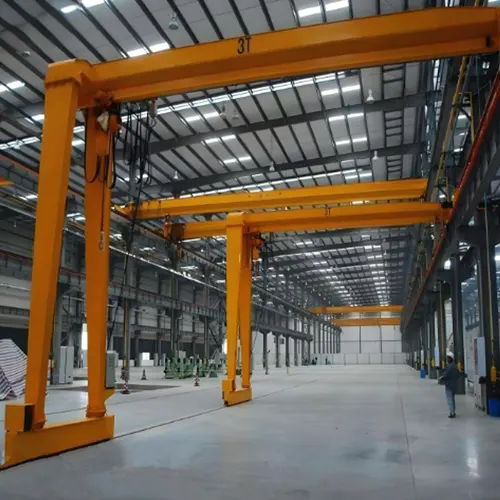Single-Leg Gantry Crane 3 Ton, 5 Ton, 10 Ton, 20 Ton Overview
Single-Leg Gantry Cranes for Sale:1-20 Ton Indoor & Outdoor Semi Gantry Cranes, Compact & Versatile. Check where Single-Leg Gantry Over Double-Leg Cranes.
| Crane type | Single leg gantry crane |
| Crane capacity | 500kg -32 ton |
| Lifting Height | As your request |
| Crane Span | As customer requirement |
Category: Full& Half Gantry
Your Trusted Gantry Crane Manufacturer & Supplier
Single-Leg Gantry Crane 3 Ton, 5 Ton, 10 Ton, 20 Ton Overview
Single-Leg Gantry Cranes for Sale:1-20 Ton Indoor & Outdoor Semi Gantry Cranes, Compact & Versatile.
Single-Leg Gantry Cranes for Sale:1-20 Ton Indoor & Outdoor Semi Gantry Cranes, Compact & Versatile. Check where Single-Leg Gantry Over Double-Leg Cranes.
Single-Leg Gantry Crane: The Compact and Versatile Lifting Solution
In the world of material handling and lifting equipment, single-leg gantry cranes have emerged as a compact and versatile solution for various industrial applications. These cranes are known for their unique design, mobility, and adaptability, making them invaluable assets in settings where efficient lifting is essential.
A single-leg gantry crane, also referred to as a monorail gantry crane, is a type of overhead lifting equipment that features a single vertical support leg on one side and a horizontal bridge beam with a lifting mechanism on the other. The primary purpose of this crane is to lift and move heavy loads within a specified area. What sets it apart from traditional overhead cranes is its ability to function without the need for a complex network of overhead rails or beams.
One of the standout features of single-leg gantry cranes is their compact design. These cranes are engineered to maximize space efficiency, making them ideal for facilities with limited overhead clearance. The single support leg ensures that they occupy a minimal footprint while providing stability and balance during lifting operations.
Main types of single leg gantry cranes
Single-leg gantry cranes come in various types based on their structures, crane girders, and applications. Here are the main types of single-leg gantry cranes in terms of these factors:

Single-Leg Box Girder Gantry Crane:
- Crane Structure: This type of single-leg gantry crane features a box girder design for the horizontal beam. The box girder provides added structural rigidity and strength, making it suitable for heavier loads.
- Applications: Box girder gantry cranes are commonly used in manufacturing plants, shipyards, and construction sites to handle medium to heavy loads with precision and stability.
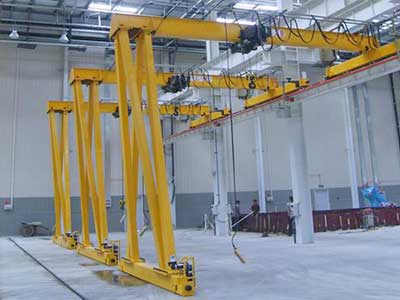
Single-Leg I-Beam Gantry Crane:
- Crane Structure: In this configuration, the crane's horizontal beam is constructed in the shape of an I-beam. It is a simpler and cost-effective design compared to the box girder.
- Applications: Single-leg I-beam gantry cranes are versatile and can be used in various industries, including warehouses, workshops, and smaller manufacturing facilities, for light to moderate lifting tasks.
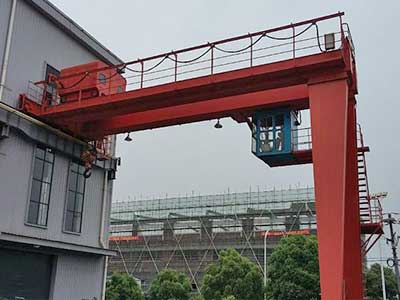
Single-Leg Wall-Mounted Gantry Crane:
- Crane Structure: These gantry cranes are designed to be mounted on an existing wall or structure, reducing the need for additional support legs. They often feature an I-beam or box girder design.
- Applications: Wall-mounted single-leg gantry cranes are commonly used in limited-space applications such as small workshops, maintenance areas, and garages.

Cantilever Single-Leg Gantry Crane:
- Crane Structure: Cantilever gantry cranes have a single vertical support leg and a horizontal beam that extends beyond the leg, creating an overhanging arm. The beam design can vary.
- Applications: Commonly used in outdoor settings such as shipyards, construction sites, and lumber yards for handling long or oversized materials.
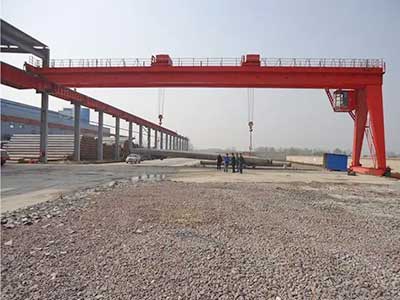
Custom-Built Single-Leg Gantry Crane:
- Crane Structure: Custom-built gantry cranes are designed and engineered to meet unique requirements, so their crane structure can vary widely. They may feature box girders, I-beams, or other configurations.
- Applications: These cranes are used in specialized industries or applications where unique lifting needs exist, such as aerospace, heavy machinery production, and large-scale manufacturing.
The choice of the right type of single-leg gantry crane depends on factors such as load capacity, available space, mobility requirements, and the specific tasks or industries in which the crane will be used. Customization options are also available to ensure that the crane meets your exact needs and application requirements.
Key Features
- Single Vertical Support Leg-The heart of a single-leg gantry crane is its single vertical support leg, which serves as the foundation for the entire structure. This leg is typically positioned at one end of the crane, offering stability while allowing the other end to remain mobile.
- Bridge Beam with Lifting Mechanism-On the opposite side of the vertical leg, a horizontal bridge beam spans the gap, housing the crane's lifting mechanism. This mechanism can consist of a hoist, trolley, or other attachments depending on the specific application.
Advantages
- Ideal for Limited Space-Single-leg gantry cranes shine in applications with restricted overhead space. Their compact design allows them to operate efficiently in areas where traditional overhead cranes might struggle to fit.
- Versatile Applications Across Industries-These cranes have found homes in diverse industries, including manufacturing, construction, warehouses, shipping yards, and more. Their adaptability makes them suitable for lifting and moving materials, machinery, and other heavy objects in various contexts.
- Cost-Effective Solution for Temporary Needs-In situations where the need for lifting and moving heavy objects is temporary or where a permanent crane installation is impractical, single-leg gantry cranes offer a cost-effective solution. Their ease of installation and portability make them an attractive option for short-term or flexible lifting requirements.
Applications where Single Leg Gantry Crane are Optimal
Single-leg gantry cranes, also known as semi-gantry cranes, are well-suited for a range of applications where their specific design and features make them an ideal choice. Here are some of the best application conditions for single-leg gantry cranes:
- Limited Space: Single-leg gantry cranes are an excellent choice when space is limited or when there are obstacles in the workspace. Their single vertical support leg allows them to operate in areas with restricted access.
- Indoor Material Handling: In manufacturing facilities, warehouses, and workshops, single-leg gantry cranes are often used for lifting and moving materials, machinery, and components. Their versatility and precise load positioning make them suitable for various indoor material handling tasks.
- Maintenance and Repair: These cranes are commonly used in maintenance and repair operations, such as servicing machinery and equipment. Their adjustable height and mobility allow for flexibility in positioning and lifting tasks.
- Loading and Unloading: Single-leg gantry cranes are used in loading and unloading materials from trucks, containers, and flatbeds. Their design makes them effective for these tasks, especially when one side of the loading area is open.
- Garages and Workshops: For automotive repair shops, garages, and small manufacturing facilities, portable single-leg gantry cranes are a popular choice for lifting engines, heavy tools, and other equipment.
- Construction Sites: In construction projects, these cranes can be employed for lifting construction materials and equipment. Their mobility and adaptability make them suitable for outdoor construction sites.
- Specialized Applications: Single-leg gantry cranes are customizable, making them an excellent choice for specialized applications where specific lifting needs must be met. They can be tailored to unique requirements in various industries.
- Light to Medium Load Handling: These cranes are suitable for handling light to medium loads, typically ranging from 1 ton to 10 tons, depending on the design and construction.
- Portability: Portable single-leg gantry cranes are designed for mobility, making them valuable for tasks that require the crane to be moved to different locations within a facility.
- Limited Budget: Single-leg gantry cranes are often more cost-effective compared to larger, more complex crane systems. They provide an economical lifting solution for many applications.
- Precise Load Positioning: In applications where precision in load positioning is critical, such as assembly lines or delicate material handling, single-leg gantry cranes can offer the necessary control.
It's important to assess the specific requirements of your application and the type of loads you'll be handling when determining whether a single-leg gantry crane is the best option. Additionally, consulting with a crane specialist or engineer can help ensure that the crane selected meets safety standards and is tailored to your unique needs.
Indoor and outdoor application of single leg gantry cranes
The design of single-leg gantry cranes for indoor and outdoor applications can differ based on several factors, including environmental conditions, load requirements, and safety considerations. Here are some key differences and considerations for single-leg gantry crane designs in indoor and outdoor settings:
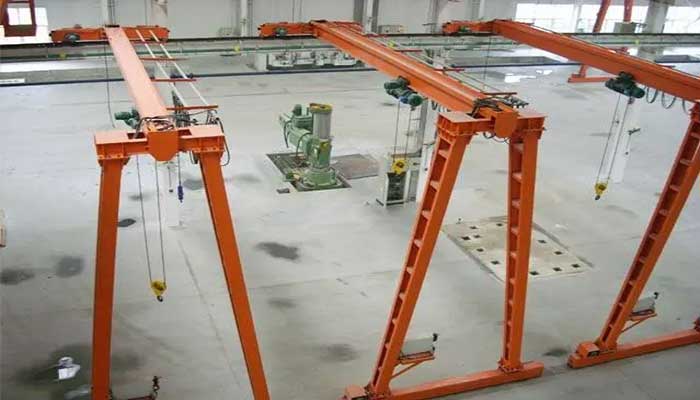
Indoor Single-Leg Gantry Crane Design, Indoor Gantry Crane Series :
- Enclosed Structure: Indoor gantry cranes are typically designed for use in controlled environments, such as manufacturing facilities and warehouses. They often have enclosed structures to protect them from dust, debris, and indoor elements.
- Smooth Flooring: These cranes are installed on smooth and level indoor floors, which may not require the same type of reinforcement as outdoor surfaces.
- Load Precision: Indoor gantry cranes may be designed for precise load positioning and handling within the confines of a building, making them suitable for manufacturing processes and assembly lines.
- Light to Medium Tonnages: The most frequently used tonnages for indoor single-leg gantry cranes typically range from 1 ton to 10 tons, depending on the specific application and industry.
- Electrical Systems: Indoor cranes often feature electrical systems that are protected from moisture and environmental factors.

- Weatherproofing: Outdoor gantry cranes must be designed to withstand exposure to weather conditions such as rain, snow, and UV radiation. They often have weatherproofing measures, including special coatings and materials.
- Heavy-Duty Structure: These cranes are usually constructed with more robust materials to withstand outdoor elements and heavier loads.
- Surface Preparation: Outdoor gantry cranes may require specialized foundations and surface preparation to ensure stability on uneven or less predictable outdoor terrain.
- Increased Tonnages: Outdoor gantry cranes are often designed for higher load capacities, commonly ranging from 5 tons to 50 tons or more, to accommodate heavier outdoor materials and equipment.
- Safety Measures: Outdoor cranes may have additional safety features, such as wind sensors and protection against extreme weather conditions.
- Corrosion Resistance: Special corrosion-resistant materials are used to prevent rust and degradation due to exposure to moisture and outdoor conditions.
- Portability: Some outdoor gantry cranes are designed to be portable, making them suitable for use in construction sites, shipyards, and other locations where mobility is required.
- Longer Span: Outdoor gantry cranes may have longer bridge spans to cover larger outdoor areas.
The choice of tonnage for a single-leg gantry crane, whether indoor or outdoor, depends on the specific requirements of the application. Tonnage requirements can vary widely, with indoor cranes typically handling lighter loads for manufacturing and warehousing purposes, while outdoor cranes are used for heavier loads in construction, shipping, and other industries. The design considerations ensure that the crane can operate effectively and safely within its intended environment.
Installation consideration of single leg gantry cranes
When installing a single-leg gantry crane that has one end of the main girder supported by a runway on the wall, several requirements and considerations should be taken into account to ensure the safety and stability of the crane system. Here are some key requirements and considerations:
Requirements for the Wall:
- Structural Integrity: The wall to which the crane will be mounted must have the structural integrity to support the weight of the crane, including the load being lifted. It should be capable of withstanding the dynamic forces generated during crane operation.
- Concrete or Steel Support: The wall should be constructed of suitable materials such as reinforced concrete or steel to provide the necessary strength and stability.
- Anchor Points: Strong anchor points or anchor bolts must be securely embedded in the wall to support the crane's attachment and to prevent any movement or shifting.
- Load-Bearing Capacity: Ensure that the wall and its foundation have sufficient load-bearing capacity to support the weight of the crane, runway, and the maximum rated load capacity of the crane.
Considerations Before Installation:
- Engineering Assessment: Before installation, it's crucial to have a structural engineer or a qualified professional assess the wall and surrounding structure to determine its suitability for mounting the crane.
- Permits and Regulations: Check local building codes and regulations to ensure compliance with any required permits and safety standards. Obtain the necessary permits before installation.
- Clearance and Height: Ensure that there is sufficient vertical clearance and height between the crane's runway and the floor, as well as any obstacles or obstructions in the workspace.
- Runway Alignment: Properly align the runway on the wall to ensure that it is level, straight, and securely anchored. Any misalignment can affect the crane's performance and safety.
- Electrical and Control Systems: Plan for the installation of electrical wiring, power supply, and control systems. Ensure that the electrical components are safely routed and protected.
- Safety Features: Install appropriate safety features such as limit switches, emergency stop buttons, and overload protection systems to enhance the safe operation of the crane.
- Operator Training: Ensure that operators are adequately trained in the safe operation of the crane. Training should cover load handling, crane controls, and safety procedures.
- Maintenance Plan: Develop a maintenance plan to regularly inspect and maintain the crane and its components to ensure its continued safe and reliable operation.
- Load Testing: Conduct load testing to verify the crane's performance and to ensure that it can handle its rated load capacity safely.
- Documentation: Keep thorough documentation of the crane's installation, inspections, maintenance, and load testing for reference and compliance with safety standards.
It's essential to work with experienced crane installation professionals and consult with engineers to ensure that the wall-mounted single-leg gantry crane is installed correctly and meets all safety and regulatory requirements. Safety should be a top priority throughout the installation process and during the crane's operation.
Maintenance and Repair Operations
Across various industries, these cranes are instrumental in maintenance and repair tasks. They assist in positioning heavy machinery, lifting and placing components, and conducting routine maintenance on equipment.
Emergency Services
In emergency situations, portable single-leg gantry cranes are invaluable tools for rescue and recovery operations. They can lift and stabilize heavy objects during critical moments.
Safety and Customization
Safety is paramount in crane operations. Single-leg gantry cranes are equipped with essential safety features, including overload protection, emergency stop buttons, and safety interlocks, to ensure the secure handling of heavy loads. Furthermore, these cranes can be customized with various accessories and attachments, such as different types of hooks, spreader bars, or clamps, to meet specific lifting requirements.
In summary, single-leg gantry cranes represent a compact and versatile lifting solution that excels in settings with limited overhead space. Their mobility and adaptability make them valuable assets across a spectrum of industries, from manufacturing and construction to warehousing and emergency services. As cost-effective alternatives for temporary or flexible lifting needs, these cranes play a vital role in optimizing material handling and enhancing operational efficiency. Whether you're navigating the challenges of a busy construction site or seeking efficient warehouse management, the single-leg gantry crane stands ready as a reliable and compact workhorse for your lifting needs.
Double-Leg Gantry Crane & Full Gantry Crane
A double-leg gantry crane, often referred to as a full gantry crane, is a type of overhead lifting equipment used for material handling and lifting tasks in various industrial environments. It consists of two vertical support legs, a horizontal bridge beam, and a trolley with a hoist. The primary purpose of a double-leg gantry crane is to efficiently lift, move, and position heavy loads within a defined workspace.
Main types of double leg gantry cranes
Double-leg gantry cranes can have different types of girders, including single girder, double girder, and truss girder designs, each with its own characteristics and applications. Here's an overview of these types of gantry cranes:

Double-Leg Single Girder Gantry Crane:
- Design: This type of gantry crane has two vertical support legs and a single horizontal bridge girder that spans the distance between the legs.
- Applications: Double-leg single girder gantry cranes are commonly used in lighter to medium-duty applications, such as warehouses, workshops, and outdoor construction sites. They are suitable for lifting loads of moderate weight and offer cost-effective solutions for material handling.
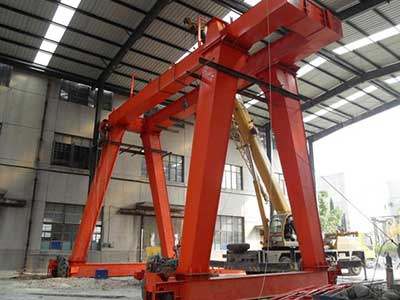
- Design: Double-girder gantry cranes have two vertical support legs and two horizontal bridge girders. The two girders provide increased stability, higher load capacity, and improved precision.
- Applications: These cranes are ideal for heavy-duty applications where precision and high load capacity are essential. They are commonly found in industries such as shipbuilding, steel manufacturing, and large-scale manufacturing facilities.
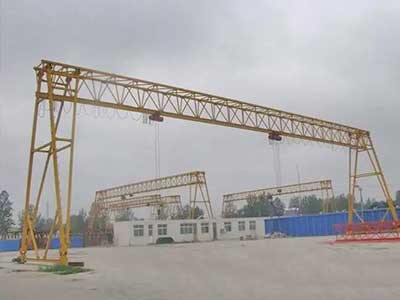
- Design: Truss girder gantry cranes have a unique girder structure with diagonal truss members in addition to the horizontal bridge girders. The truss design offers a combination of strength and reduced weight.
- Applications: Truss girder gantry cranes are suitable for outdoor applications and locations with high wind exposure. They are often used in industries like construction, timber yards, and open storage areas for handling heavy and oversized loads.
Each type of gantry crane has its advantages and is selected based on specific load capacity requirements, precision needs, environmental conditions, and budget considerations. The choice of the appropriate gantry crane design depends on the unique needs of the application and the materials being handled.
Key Features
Double-leg gantry cranes are characterized by several key features:
- Two Vertical Support Legs: These legs provide stability and support for the entire crane structure, ensuring safe lifting operations.
- Horizontal Bridge Beam: The bridge beam spans between the two support legs, offering a secure pathway for the trolley and hoist to move along. The bridge beam can be customized in terms of length and design.
- Trolley with Hoist: The trolley is equipped with a hoist mechanism that allows for the lifting and lowering of loads. It travels along the bridge beam, enabling precise load positioning.
- Control System: Double-leg gantry cranes come with control systems that enable operators to manage the crane's movements. These controls can be pendant-mounted, radio remote-controlled, or integrated into a control room.
Advantages
Advantages of double-leg gantry cranes include:
- High Load Capacity: They are capable of lifting and moving heavy loads, making them suitable for various industries and applications.
- Versatility: Double-leg gantry cranes are versatile and can handle a wide range of load sizes and types.
- Precision: The trolley and hoist system allows for precise load positioning, making them ideal for tasks that require accuracy.
- Stability: With two vertical support legs, they offer enhanced stability compared to single-leg gantry cranes.
Typical Applications
Double-leg gantry cranes find application in various industries and tasks, including:
- Manufacturing: For moving and positioning machinery and materials within a production facility.
- Warehousing: For loading and unloading cargo from trucks and moving heavy items in warehouses.
- Shipbuilding: In shipyards to handle large ship components and equipment.
- Construction: For lifting and placing construction materials and components.
- Steel Mills: In steel manufacturing facilities to handle heavy metal products.
Structural Considerations
- Materials: Double-leg gantry cranes are typically constructed from steel or other durable materials to ensure strength and stability.
- Customization: The design of the crane, including the bridge beam length and hoist capacity, can be customized to match specific application requirements.
Safety and Precision
- Safety Features: Double-leg gantry cranes are equipped with safety features such as limit switches, overload protection, emergency stop buttons, and warning systems to ensure safe operations.
- Precision Control: Operators can precisely control the crane's movements, which is essential for safely handling heavy loads in confined spaces.
Double-leg gantry cranes, also known as full gantry cranes, are essential tools in various industries due to their high load capacity, versatility, stability, and precision. Their ability to efficiently lift and move heavy loads makes them valuable for tasks ranging from manufacturing and warehousing to shipbuilding and construction. When properly designed and equipped with safety features, these cranes contribute to improved productivity and workplace safety.
In conclusion, the double-girder gantry crane stands as a beacon of heavy-duty lifting power in the world of industry. Its twin vertical support legs, robust horizontal bridge, and exceptional lifting capacity make it the solution of choice for industries dealing with the heaviest of loads. From steel mills and shipyards to container terminals and automotive plants, this crane answers the call of heavy industry, providing the reliability, precision, and strength required to meet the most demanding lifting challenges. When the task at hand demands unwavering lifting power, the double-girder gantry crane delivers with unparalleled might and precision.
Comparing Single-Leg Gantry Cranes and Double Legs Gantry Cranes
Double-leg gantry cranes and single-leg gantry cranes are both types of overhead cranes used for material handling in various industrial applications. They have some key differences in terms of design, capacity, stability, and use cases. Here's a comparison between the two:
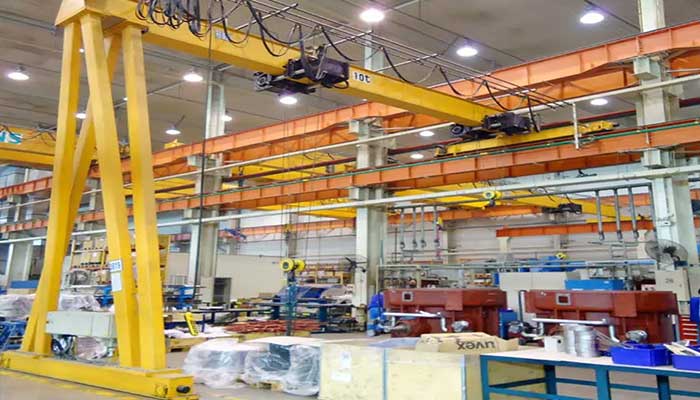
Single leg gantry crane with single girder crane design 10 ton
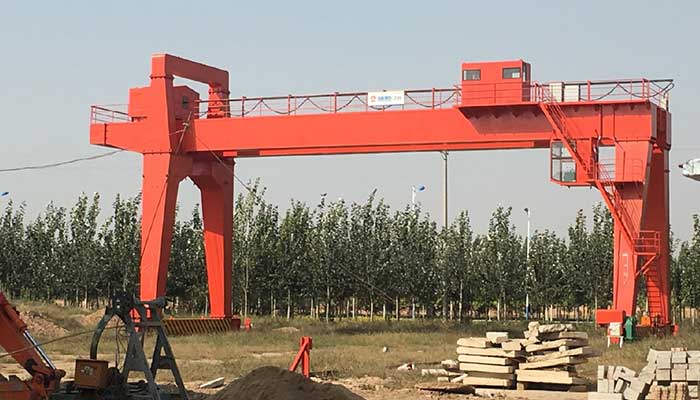
Double leg gantry crane with double leg gantry crane design
Number of Legs:
- Double-Leg Gantry Crane: As the name suggests, a double-leg gantry crane has two vertical support legs. These legs are typically parallel to each other and provide stability and support for the crane.
- Single-Leg Gantry Crane: A single-leg gantry crane has only one vertical support leg. It relies on the structural integrity of this single leg and often requires additional support from the building or structure to maintain stability.
Stability:
- Double-Leg Gantry Crane: Double-leg gantry cranes tend to be more stable due to the presence of two support legs. They can handle heavier loads and offer better stability across a wider range of load capacities.
- Single-Leg Gantry Crane: Single-leg gantry cranes are generally less stable than double-leg cranes. They are typically used for lighter loads and may require additional support structures or anchoring to prevent tipping.
Load Capacity:
- Double-Leg Gantry Crane: These cranes are designed to handle heavier loads compared to single-leg gantry cranes. They are suitable for heavy industrial applications.
- Single-Leg Gantry Crane: Single-leg gantry cranes are better suited for lighter loads and are often used in smaller workshops or facilities.
Cost:
- Double-Leg Gantry Crane: Double-leg gantry cranes are typically more expensive to manufacture and install due to their larger and more robust structure.
- Single-Leg Gantry Crane: Single-leg gantry cranes are generally more cost-effective, making them a popular choice for smaller businesses with lighter material handling needs.
Space Requirements:
- Double-Leg Gantry Crane: Double-leg gantry cranes require more floor space due to their two support legs. They may not be suitable for facilities with limited space.
- Single-Leg Gantry Crane: Single-leg gantry cranes require less floor space, making them a practical choice when space is constrained.
Versatility:
- Double-Leg Gantry Crane: These cranes are more versatile and can handle a wide range of load sizes and weights.
- Single-Leg Gantry Crane: Single-leg gantry cranes are limited in terms of load capacity and are better suited for specific, lighter-duty applications.
In summary, the choice between a double-leg gantry crane and a single-leg gantry crane depends on factors such as the required load capacity, available space, budget, and specific application needs. Double-leg gantry cranes offer greater stability and capacity but come at a higher cost and space requirement, while single-leg gantry cranes are more economical but have limitations in terms of load capacity and stability.
In summary, the choice between a single-leg gantry crane and a double-girder gantry crane hinges on your specific lifting requirements, available space, and budget considerations. While single-leg gantry cranes offer versatility and cost-effectiveness, double-girder gantry cranes provide unparalleled lifting power and stability, making them the preferred option for heavy-duty industrial tasks. Understanding the nuances of these two crane types ensures that you select the perfect lifting solution for your unique needs.
In conclusion, the choice between single-leg gantry cranes and double-girder gantry cranes depends on the specific lifting requirements, available space, and budget constraints of the application. Single-leg gantry cranes excel in compact spaces and versatility, while double-girder gantry cranes provide the heavy-duty lifting power needed for demanding industrial tasks. Careful consideration of these factors will help users select the most suitable crane for their needs.
How to select from single leg gantry crane and double leg gantry cranes ?
Let's us check more details on how to select between a single-leg and double-leg gantry crane:
- Load Capacity: - Determine the heaviest load you need to handle. If you regularly handle heavy or oversized loads, a double-leg gantry crane with its higher load capacity may be necessary. Single-leg gantry cranes are better suited for lighter loads.
- Space Constraints: - Measure the available workspace carefully. Double-leg gantry cranes require more floor space due to their two support legs, while single-leg gantry cranes occupy less space. Ensure that the crane you choose fits comfortably within your workspace without obstructing other operations.
- Budget Considerations: - Evaluate your budget for the crane purchase and installation. Double-leg gantry cranes typically have a higher upfront cost due to their larger size and greater complexity. Consider both the initial investment and long-term operating costs.
- Load Positioning and Precision: - Assess the level of precision required for your lifting tasks. Double-leg gantry cranes offer better stability and precise load positioning, making them suitable for applications where accuracy is critical. Single-leg gantry cranes may be less precise in load placement.
- Safety and Stability: - Consider the safety implications. If stability is a top concern, especially in windy or unstable environments, a double-leg gantry crane's additional support legs can provide enhanced stability. Single-leg gantry cranes may require additional measures to ensure stability, such as floor anchoring.
- Maintenance and Operating Costs: - Estimate ongoing maintenance and operating costs. Double-leg gantry cranes may have higher maintenance costs due to their complexity, larger components, and potential for more wear and tear.
- Future Growth and Needs: - Think about potential growth in your operations. If you expect your lifting needs to increase in the future, investing in a double-leg gantry crane with higher load capacity can be a more cost-effective long-term solution.
- Application-Specific Requirements: - Consider the unique demands of your industry or application. Some industries, such as shipbuilding or steel manufacturing, may require the heavy lifting capabilities of double-leg gantry cranes, while others, like smaller manufacturing or assembly, can be adequately served by single-leg gantry cranes.
- Consultation with Experts: - Seek advice from crane manufacturers or specialists who can perform a detailed assessment of your requirements and provide customized recommendations based on your specific needs and constraints.
- Regulatory Compliance: - Ensure that the selected crane complies with local safety and regulatory standards. Compliance is crucial for the safety of your operations and workforce.
In summary, selecting the right gantry crane type (single-leg or double-leg) involves a careful evaluation of your load requirements, available space, budget, precision needs, safety concerns, and future growth expectations. It's essential to strike a balance between your immediate needs and long-term considerations to make an informed decision that optimizes efficiency and safety in your material handling processes.
Related Products

Latest project
150 Ton Overhead Crane Installation Feedback – Paraguay Case
QDX 150 ton overhead crane in action in Paraguay. Installation photos, video, and client feedback show performance, safety, and heavy-lifting efficiency.
Free consultation to Confirm Parameters & Specifications and Get
Latest Crane Price & Crane Rate.
- Types of overhead cranes : _______?
- Optional: Overhead travelling crane, goliath gantry crane,Slewing jib crane, Single girder or double girder crane,small portable crane or kbk crane, etc.
- Capacity of overhead crane: _______?
- Optional: 0.25ton, 0.5 ton, 1 ton, 2 ton, 3ton, 5 ton, 10 ton,15ton, 20ton, 25 ton, 30ton,35ton, up to 550ton, etc.
- Crane span & lifting height : _______?
- Crane travelling length : _____?
- Control of overhead crane:_______?
- Optional: pendant/ remote/cabin control
- Voltage supply of overhead crane:_____?
- Eg,: 380V50/60HZ,3Phase or others,etc.
- Application/usage of crane:_______?
- Eg,: Steel mill, ,injection mold, cement,stone, concrete,granite, general manufacturing, etc.
Just leave a message via the contact form and our hoist and crane engineer will contact you with in 24working hours.
Get In Touch
